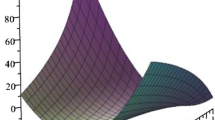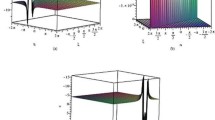Abstract
In the present paper, we consider a special class of third-order polynomial evolutionary equations. These equations, via Lie theory admit the same one-parameter point transformations which leave the equations invariant. Reductions with these invariant functions lead to highly nonlinear third-order ordinary differential equations. We use a power series to establish interesting solutions to the reduced equations, whereby recurrence relations occur and convergence of the series may be tested. Finally, the conserved vectors of the class are constructed.
Similar content being viewed by others
Avoid common mistakes on your manuscript.
1 Introduction
Fujimoto–Watanabe, in a remarkable paper [1] decades ago, derived a complete list of third-order polynomial evolution equations of not normal type [2] with nontrivial Lie–Bäcklund symmetries. It is possible to construct chains of differential substitutions which connect some of the equations to the KdV, Sawada–Kotera and Kaup equations [3]. Most of the equations possess a recursion operator and the Lie algebras are commutative, namely the four equations of interest are
where \(\alpha \ne 0\) is an arbitrary constant.
In the literature, some Fujimoto–Watanabe equations have been studied, but not necessarily the ones listed above. Liu [4] used a complete discrimination system to obtain the classifications of traveling wave solutions of a Fujimoto–Watanabe equation. By the method of dynamical systems, the bifurcations and dynamics of traveling wave solutions of a Fujimoto–Watanabe equation were analysed [5, 6], and also phase portraits and periodic solutions were described. In [7], a Fujimoto–Watanabe equation (not listed above) was studied from the perspective of Lie symmetries.
Symmetry methods and conservation laws are deeply intertwined in the analysis of partial differential equations [8,9,10]. The theory relating to symmetries is well known and is best studied from the book [11]. In this paper, we explore how symmetry methods combine with power series to arrive at solutions. The resulting equations obtained through Lie reductions are difficult to solve, and most other techniques will not work. Power series are a useful tool to find approximate solutions, and the solutions may be made exact by finding a recurrence relation of the series.
The plan of the paper follows. In Sect. 2, we present the symmetry details possessed by the four equations, together with the commutator, adjoint and group properties. Section 3, contains the reductions and power series solutions, while the next section demonstrates the convergence of a solution. The conserved vector components are given in Sect. 5, and a conclusion follows in Sect. 6.
2 Symmetries and groups
First of all, let us consider a one-parameter Lie group of infinitesimal transformations:
with the infinitesimal \(\varepsilon \ll 1\). The vector field associated with the above transformations can be written as
The symmetry group of the equation will be generated by the vector field of the above form. Applying the prolongation to the given equations, we find the coefficient functions \(\xi (x,t,u),~\tau (x,t,u)\) and \(\phi (x,t,u)\) that must satisfy the Lie symmetry condition.
The Lie point symmetries of Eqs. (1)–(4) are
with Lie brackets \( [X_i,X_j]=X_iX_j-X_jX_i\), given in Table 1.
Thus, we have the corresponding one-parameter groups \(G_i~(i=1,2,3)\) generated by the symmetries \(X_i\) of the four equations, as
We can see that \(G_1\) is a space translation, \(G_2\) is a time translation, and \(G_3\) is a scaling transformation.
The adjoints corresponding to (9) are given in Table 2,
where we require the adjoints to calculate the one-dimensional subalgebras. The approach for the one-dimensional optimal system is provided in [12]. That is, take a general element from the Lie algebra and reduce it to its simplest like form by applying carefully chosen adjoint transformations
Thus, for the class of equations (1)–(4), we obtain the optimal system of one-dimensional subalgebras
where a is a constant and \(\epsilon =0,\pm 1\).
3 Solutions via power series
In this section, we draw on the optimal system of one-dimensional subalgebras to reduce Eqs. (1)–(4) to ordinary differential equations. Some of the subsequent ordinary differential equations are highly nonlinear and may be solved using the power series method [13], or see [14] for an application.
Reducing Eqs. (1)–(4) by the generator \(X_1\) gives
where \(u(x,t)=y(t)\). Solving (13) gives
where \(c_1\) is an arbitrary constant. Hence, each of the four equations possess the constant solution \(u(x,t)=c_1\).
3.1 The case of Eq. (1)
Reducing equation (1) by \(X_2+\epsilon X_1\) gives the travelling wave reduction
where \(u(x,t)=p(s)\) and \(s=\frac{t \epsilon -x}{\epsilon }\).
A reduction of (1) by \(X_3+a X_1\) gives
where \(u(x,t)=e^{\frac{x}{a}}y(z)\) and \(z=e^{\frac{3x}{a}}t\).
Let us consider the reduced equation (15) with \(\epsilon =1\). A substitution of the power series
with \(a_{r{_1}}\) as unknown constants to be determined, into (15) provides
From (18) comparing coefficients of the power of s, we find that \(a_0,a_1,a_2\) are arbitrary,
and
In general for \(r{_1}\ge 3\), we have
Therefore, from (19)–(21), for arbitrary constants \(a_{0}\ne 0, a_1, a_2\) we obtain the power series solution for equation (15), viz.
An inversion of the transformation gives the solution to the PDE (1), namely
Similarly, and very tediously, we can construct power series solutions to all reduced equations in this paper. We omit the details for all other cases. The proof of convergence of the solution is discussed later.
A solution to (16) is found from substituting
into (16) and similar to the above discussion, we get
3.2 The case of Eq. (2)
In the same vein, reducing equation (2) by \(X_2+\epsilon X_1\) gives
while \(X_3+a X_1\) leads to
For this case, we find the solutions
and
respectively.
3.3 The case of Eq. (3)
Reducing the equation by \(X_2+\epsilon X_1\) yields
and \(X_3+a X_1\) gives
In this case, we obtain
and
for the above ODEs.
3.4 The case of Eq. (4)
Similarly, for Eq. (4), \(X_2+\epsilon X_1\), the travelling wave reduction produces
and \(X_3+a X_1\) gives
with corresponding solutions
and finally,
4 Convergence—exact power series
Next we prove the convergence of the power series solution (17). The rest of the series solutions above may be tested for convergence in the same manner. Consider, the case of Eq. (1), the first reduction. From (21) we obtain
where \(r_1=3,4,5 \ldots \), and \(M=max\left\{ \frac{1}{a^{2}_{0}},\frac{4|\alpha |}{3a^{2}_{0}}\right\} .\)
Suppose we have the power series \(\mu =R(s)=\sum ^{\infty }_{{r_1}=0}p_{{r_1}}s^{{r_1}}\), where
and
for \(r_1=3,4,5 \ldots \). Hence,
Next we prove that \(\mu \) is convergent in a neighborhood of a point. In fact, \(\mu \) is a majorant series of equation (17) and it can be written as follows:
where \(\nu (s)\) is a polynomial with respect to s, that is,
\(\nu (s)=-3 p_0 p_1^2\,s^5-3 p_0^2 p_2 s^5-p_1^2 p_3 s^5-4 p_0 p_2 p_3 s^5-4 p_0 p_1 p_4 s^5-2 p_0^2 p_5 s^5-p_0 p_2^2\,s^4-3 p_0^2 p_1 s^4-4 p_0 p_1 p_3 s^4-2 p_0^2 p_4 s^4-2 p_0 p_1 p_2 s^3-2 p_0^2 p_3 s^3-p_0 p_1^2\,s^2-p_0^2 p_2 s^2-p_0^3\,s^3-p_0^2 p_1 s\).
Let implicit function equation be:
where we obtain that \(F(0,p_{0})=0\) and \(F_{\mu }(0,r_{0})=1-2Mp_0^2\ne 0\). By virtue of the implicit function theorem [15], \(\mu =R(s)\) is analytic and convergent in a neighbourhood of the point \((0,p_{0})\) in the plane and with a positive radius. Then the power series solution (17) is convergent in the neighbourhood of a point \((0,p_{0})\)
Therefore, (17) can be written as
Thus, the exact power series solution of equation (1) can be written as
where \(a_{0}\ne 0,a_1,a_{2},\) are arbitrary constants, \(a_3,a_4,a_5\) are given in (19)–(20) and the rest of the constants are to be determined by (21).
5 Conservation laws
In this section, we derive the conservation laws associated with Eqs. (1)–(4). A current \({ T}=(T^1,\ldots ,T^n)\) is conserved if it satisfies
along the solutions of a given differential system, say \(G_\alpha (x,u^{(k)})=0\). Multipliers or integrating factors, that produce conservation laws, are called \(\Lambda ^\alpha \) [16]. They satisfy the relation
for all functions \(u^\alpha \) and the overdetermined equations for \(\Lambda ^\alpha \) are
where \({{\delta }\over {\delta u^\alpha }}\) is the Euler operator. In the Tables 3 and 4, we list the conservation laws for each of our four cases.
6 Conclusion
A special class of third-order evolutionary equations were investigated. Several distinct ordinary differential equations were obtained by reduction with the optimal system. In particular, these equations are highly nonlinear with solutions best found by power series. Through the results obtained in this paper, it can be found that the power series method is effective in solving ordinary differential equations admitted by the Lie group reduction method. A standard technique for testing the convergence of such solutions is demonstrated. Finally, the conservation laws may be used for further studies of gaining insights into the given class of equations.
Data Availability Statement
Not applicable.
References
Fujimoto, A.; Watanabe, Y.: Polynomial evolution equations of not normal type admitting nontrivial symmetries. Phys. Lett. A 136, 294–9 (1989)
Fokas, A.S.: A symmetry approach to exactly solvable evolution equations. J. Math. Phys. 21, 1318 (1980)
Sakovich, S.Y.: Fujimoto–Watanabe equations and differential substitutions. J. Phys. A Math. Gen. 24, LS19 (1991)
Liu, C.S.: Applications of complete discrimination system for polynomial for classifications of traveling wave solutions to nonlinear differential equations. Comput. Phys. Commun. 181, 317–324 (2010)
Shi, L.J.; Wen, Z.S.: Bifurcations and dynamics of traveling wave solutions to a Fujimoto–Watanabe equation. Commun. Theor. Phys. 69, 631–636 (2010)
Shi, L.J.; Wen, Z.S.: Dynamical behaviors of traveling wave solutions to a Fujimoto–Watanabe equation. Chin. Phys. B 27, 090201 (2018)
Dong, H.; Fang, Y.; Guo, B.; Liu, Y.: Lie point symmetry, conservation laws and exact power series solutions to the Fujimoto–Watanabe equation. Quaest. Math. 43(10), 1349–1365 (2019)
Jamal, S.: Approximate conservation laws of nonvariational differential equations. Mathematics 2019(7), 574 (2019)
Obaidullah, U.; Jamal, S.: A computational procedure for exact solutions of Burgers’ hierarchy of nonlinear partial differential equations. J. Appl. Math. Comput. 65, 541–551 (2021)
Jamal, S.: Imaging noise suppression: fourth-order partial differential equations and travelling wave solutions. Mathematics 8, 2019 (2020)
Stephani, H.: Differential Equations: Their Solutions Using Symmetries. Cambridge University Press, New York (1989)
Olver, P.J.: Applications of Lie Groups to Differential Equations, 2nd edn Springer, New York (1993)
Asmar, N.H.: Partial Differential Equations with Fourier Series and Boundary Value Problems, 2nd edn China Machine Press, Beijing (2005)
Liu, H.; Li, J.; Zhang, Q.: Lie symmetry analysis and exact explicit solutions for general Burgers’ equation. J. Comput. Appl. Math. 228(1), 1–9 (2009)
Rudin, W.: Principles of Mathematical Analysis, 3rd edn China Machine Press, Beijing (2004)
Steudel, H.: Uber die Zuordnung zwischen Invarianzeigenschaften und Erhaltungssätzen. Z. Nat. 17, 129–132 (1962)
Funding
No funding received.
Author information
Authors and Affiliations
Corresponding author
Ethics declarations
Conflict of interest
We have no conflict of interest to declare.
Additional information
Publisher's Note
Springer Nature remains neutral with regard to jurisdictional claims in published maps and institutional affiliations.
Rights and permissions
Open Access This article is licensed under a Creative Commons Attribution 4.0 International License, which permits use, sharing, adaptation, distribution and reproduction in any medium or format, as long as you give appropriate credit to the original author(s) and the source, provide a link to the Creative Commons licence, and indicate if changes were made. The images or other third party material in this article are included in the article’s Creative Commons licence, unless indicated otherwise in a credit line to the material. If material is not included in the article’s Creative Commons licence and your intended use is not permitted by statutory regulation or exceeds the permitted use, you will need to obtain permission directly from the copyright holder. To view a copy of this licence, visit http://creativecommons.org/licenses/by/4.0/.
About this article
Cite this article
Gwaxa, B., Jamal, S. & Johnpillai, A.G. On the conservation laws, Lie symmetry analysis and power series solutions of a class of third-order polynomial evolution equations. Arab. J. Math. 12, 553–564 (2023). https://doi.org/10.1007/s40065-023-00417-0
Received:
Accepted:
Published:
Issue Date:
DOI: https://doi.org/10.1007/s40065-023-00417-0




